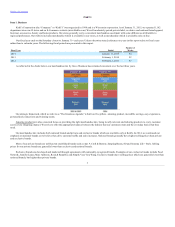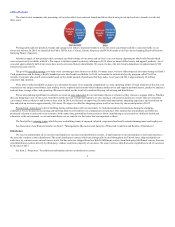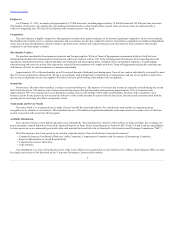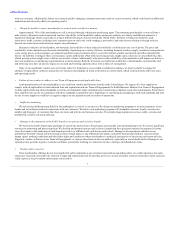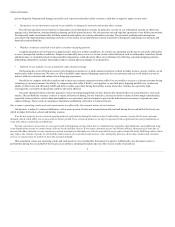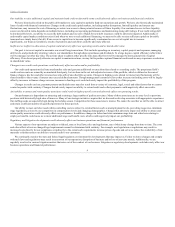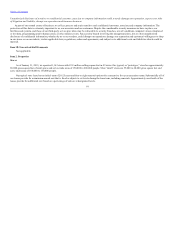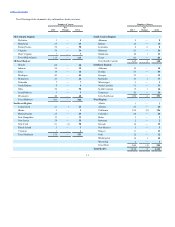Kohl's 2014 Annual Report Download - page 9
Download and view the complete annual report
Please find page 9 of the 2014 Kohl's annual report below. You can navigate through the pages in the report by either clicking on the pages listed below, or by using the keyword search tool below to find specific information within the annual report.
Table of Contents
Our inability to raise additional capital and maintain bank credit on favorable terms could adversely affect our business and financial condition.
We have historically relied on the public debt markets to raise capital to partially fund our operations and growth. We have also historically maintained
lines of credit with financial institutions. Changes in the credit and capital markets, including market disruptions, limited liquidity and interest rate
fluctuations, may increase the cost of financing or restrict our access to these potential sources of future liquidity. Our continued access to these liquidity
sources on favorable terms depends on multiple factors, including our operating performance and maintaining strong debt ratings. If our credit ratings fall
below desirable levels, our ability to access the debt markets and our cost of funds for new debt issuances could be adversely impacted. Additionally, if
unfavorable capital market conditions exist if and when we were to seek additional financing, we may not be able to raise sufficient capital on favorable
terms and on a timely basis (if at all). If our access to capital was to become significantly constrained or our cost of capital was to increase
significantly, our financial condition, results of operations and cash flows could be adversely affected.
Inefficient or ineffective allocation of capital could adversely affect our operating results and/or shareholder value.
Our goal is to invest capital to maximize our overall long-term returns. This includes spending on inventory, capital projects and expenses, managing
debt levels, and periodically returning value to our shareholders through share repurchases and dividends. To a large degree, capital efficiency reflects how
well we manage our other key risks. The actions taken to address other specific risks may affect how well we manage the more general risk of capital
efficiency. If we do not properly allocate our capital to maximize returns, we may fail to produce optimal financial results and we may experience a reduction
in shareholder value.
Changes in our credit card operations could adversely affect our sales and/or profitability.
Our credit card operations facilitate merchandise sales and generate additional revenue from fees related to extending credit. The proprietary Kohl's
credit card accounts are owned by an unrelated third-party, but we share in the net risk-adjusted revenue of the portfolio, which is defined as the sum of
finance charges, late fees and other revenue less write-offs of uncollectible accounts. Changes in funding costs related to interest rate fluctuations will be
shared similar to the revenue if interest rates exceed defined amounts. Though management currently believes that increases in funding costs will be largely
offset by increases in finance charge revenue, increases in funding costs could adversely impact the profitability of this program.
Changes in credit card use, payment patterns and default rates may also result from a variety of economic, legal, social and other factors that we cannot
control or predict with certainty. Changes that adversely impact our ability to extend credit and collect payments could negatively affect our results.
An inability to attract and retain quality associates could result in higher payroll costs and adversely affect our operating results.
Our performance is dependent on attracting and retaining a large number of quality associates. Many of those associates are in entry level or part-time
positions with historically high rates of turnover. Many of our strategic initiatives require that we hire and/or develop associates with appropriate experience.
Our staffing needs are especially high during the holiday season. Competition for these associates is intense. We cannot be sure that we will be able to attract
and retain a sufficient number of qualified personnel in future periods.
Our ability to meet our labor needs while controlling costs is subject to external factors such as unemployment levels, prevailing wage rates, minimum
wage legislation, actions by our competitors in compensation levels and changing demographics. Changes that adversely impact our ability to attract and
retain quality associates could adversely affect our performance. In addition, changes in federal and state minimum wage laws and other laws relating to
employee benefits could cause us to incur additional wage and benefit costs, which could negatively impact our profitability.
Regulatory and litigation developments could adversely affect our business operations and financial performance.
Various aspects of our operations are subject to federal, state or local laws, rules and regulations, any of which may change from time to time. The costs
and other effects of new or changed legal requirements cannot be determined with certainty. For example, new legislation or regulations may result in
increased costs directly for our compliance or indirectly to the extent such requirements increase prices of goods and services, reduce the availability of raw
materials or further restrict our ability to extend credit to our customers.
We continually monitor the state and federal legal/regulatory environment for developments that may impact us. Failure to detect changes and comply
with such laws and regulations may result in an erosion of our reputation, disruption of business and/or loss of associate morale. Additionally, we are
regularly involved in various litigation matters that arise out of the conduct of our business. Litigation or regulatory developments could adversely affect our
business operations and financial performance.
9



